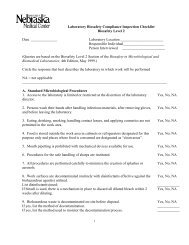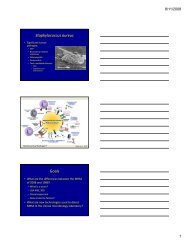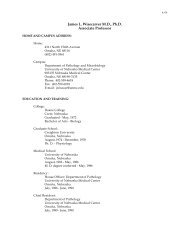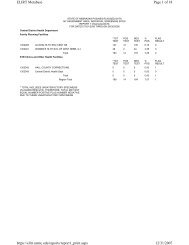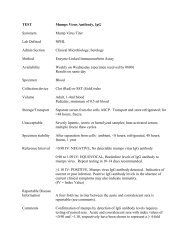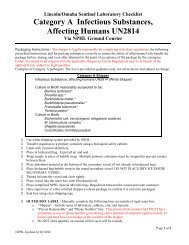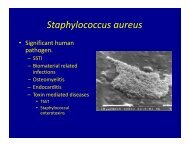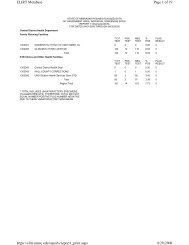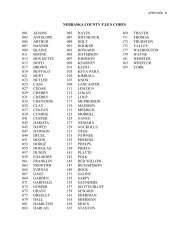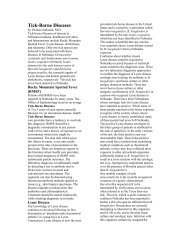Specimen Collection Table of Contents - the Nebraska Public Health ...
Specimen Collection Table of Contents - the Nebraska Public Health ...
Specimen Collection Table of Contents - the Nebraska Public Health ...
You also want an ePaper? Increase the reach of your titles
YUMPU automatically turns print PDFs into web optimized ePapers that Google loves.
<strong>Specimen</strong> <strong>Collection</strong> <strong>Table</strong> <strong>of</strong> <strong>Contents</strong><br />
These documents fall outside <strong>of</strong> <strong>the</strong> <strong>Nebraska</strong> <strong>Public</strong> <strong>Health</strong> Laboratory document<br />
control system; subsequent updates or changes will not automatically be forwarded to<br />
your facility.<br />
Basic <strong>Specimen</strong> <strong>Collection</strong> Guidelines …………………………………… Page 1<br />
Bordetella pertussis Culture and DFA ……………………………………. Page 2<br />
Bordetella pertussis PCR …………………………………………………. Page 3<br />
Nasopharyngeal Washings ……………………………………………….. Page 5<br />
Nose ………………………………………………………………………. Page 7<br />
Sputum ……………………………………………………………………. Page 8<br />
Stool ………………………………………………………………………. Page 9<br />
Throat ……………………………………………………………………... Page 11<br />
Urine ………………………………………………………………………. Page 12<br />
Vomitus …………………………………………………………………… Page 13<br />
If you have questions about proper specimen collection, please call<br />
NPHL Client Services at 402-559-2440 or toll free at 1-866-290-1406.<br />
9/5/2006
Steven H. Hinrichs, M.D., Director, <strong>Public</strong> <strong>Health</strong><br />
Laboratory<br />
Thomas J. Safranek, M.D., <strong>Nebraska</strong> State<br />
Epidemiologist<br />
SPECIMEN COLLECTION GUIDELINES<br />
981180 <strong>Nebraska</strong> Medical Center<br />
Omaha, NE 68198-1180<br />
Phone: (402) 559-2440<br />
Toll Free: 866-290-1406<br />
Fax: (402) 559-9497<br />
The proper collection <strong>of</strong> a specimen for culture is <strong>the</strong> most important step in <strong>the</strong> recovery <strong>of</strong><br />
pathogenic organisms responsible for infectious disease. A poorly collected specimen may lead<br />
to failure in isolating <strong>the</strong> causative organism(s) and result in <strong>the</strong> recovery and subsequent<br />
treatment <strong>of</strong> contaminating organisms.<br />
Basic Concepts for <strong>Collection</strong><br />
• Collect <strong>the</strong> specimen from <strong>the</strong> actual site <strong>of</strong> infection, avoiding contamination from<br />
adjacent tissues or secretions.<br />
• Collect <strong>the</strong> specimen at optimal times (for example, early morning sputum for AFB<br />
culture).<br />
• Collect a sufficient quantity <strong>of</strong> material.<br />
• Use appropriate collection devices: sterile, leak-pro<strong>of</strong> specimen containers.<br />
• Use appropriate transport media.<br />
• Whenever possible, collect specimens prior to administration <strong>of</strong> antibiotic or antiviral<br />
medication.<br />
• Properly label <strong>the</strong> specimen and complete <strong>the</strong> test request form/process. The source <strong>of</strong><br />
specimen is required.<br />
• Minimize transport time. Maintain an appropriate environment between collection <strong>of</strong><br />
specimens and delivery to <strong>the</strong> laboratory. (If special transport media is required please<br />
make sure this obtained prior to specimen collection)<br />
• If appropriate, decontaminate <strong>the</strong> skin surface prior to collecting specimen.<br />
If you have questions about proper specimen collection, please call<br />
NPHL Client Services at 402-559-2440 or toll free at 1-866-290-1406.<br />
Department <strong>of</strong> Pathology and Microbiology at <strong>the</strong> University <strong>of</strong> <strong>Nebraska</strong> Medical Center<br />
Samuel M. Cohen, M.D., Ph.D., Chairman James L. Wisecarver, M.D., Ph.D., Director, Clinical Laboratory 1
Bordetella pertussis Culture and DFA<br />
• <strong>Specimen</strong> <strong>of</strong> choice is a nasopharyngeal swab or aspirate. Ideally <strong>the</strong> specimen is<br />
collected and plated at bedside and transported to <strong>the</strong> lab as soon as possible.<br />
• Use a calcium alginate or Dacron swab on a flexible wire handle to collect <strong>the</strong><br />
specimen.<br />
• Seat <strong>the</strong> patient comfortably. Tilt <strong>the</strong> head back.<br />
• If available, insert a nasal speculum. Press <strong>the</strong> swab through <strong>the</strong> nares until resistance is<br />
met due to contact with <strong>the</strong> nasopharynx.<br />
• Rotate <strong>the</strong> swab gently and allow <strong>the</strong> swab to maintain contact with <strong>the</strong> nasopharynx for<br />
20-30 seconds or until coughing is induced.<br />
• Plate directly onto Charcoal Blood agar or place swab into charcoal transport medium.<br />
Label with <strong>the</strong> patient's name and identification number. Transport to <strong>the</strong> lab at ambient<br />
temperature.<br />
• Repeat <strong>the</strong> procedure with <strong>the</strong> second swab if DFA is ordered. Gently roll <strong>the</strong> swab onto<br />
two double-well fluorescent microscope slides. Label both slides with <strong>the</strong> patient's name,<br />
identification number and <strong>the</strong> date.<br />
• Transport <strong>the</strong> slides (placed in a microscope slide mailer) at ambient temperature.<br />
If you have questions about proper specimen collection, please call<br />
NPHL Client Services at 402-559-2440 or toll free at 1-866-290-1406.<br />
2
Pertussis PCR<br />
• Nasopharyngeal wash in sterile container or nasopharyngeal swab<br />
• Collect nasopharyngeal swab with Amies, Charcoal, Dacron or cotton swab. (B. Pertussis<br />
culture must be submitted on separate Charcoal swab if ordered.) DO NOT USE swabs<br />
made with wooden sticks.<br />
• Swabs are available from NPHL. See following collection procedure.<br />
• Transport to lab dry, refrigerated.<br />
Washing:<br />
• Cut <strong>of</strong>f <strong>the</strong> distal end <strong>of</strong> <strong>the</strong> butterfly ca<strong>the</strong>ter (needle and butterfly) ca<strong>the</strong>ter extension set<br />
so that about 2-3 inches <strong>of</strong> tubing are left attached to <strong>the</strong> hub.<br />
• Draw up 2-3 mL <strong>of</strong> saline into a syringe.<br />
• Attach syringe to hub <strong>of</strong> butterfly ca<strong>the</strong>ter. Purge tubing with saline.<br />
• Put on gloves, gown, mask and eye protection.<br />
• Gently remove excess mucous from patient's nose. (If patient is an adult, ask <strong>the</strong> patient<br />
to gently blow nose. For pediatrics, a bulb syringe may be used to remove excess<br />
mucous.)<br />
• Position patient in supine position with <strong>the</strong> head <strong>of</strong> bed up 30°. The head should be<br />
turned to one side and tilted slightly backward.<br />
• Stabilize <strong>the</strong> patient's head and gently place <strong>the</strong> ca<strong>the</strong>ter into <strong>the</strong> nare. Placement should<br />
be in <strong>the</strong> nare (nasal wall), not <strong>the</strong> nasopharynx. Depending on <strong>the</strong> size <strong>of</strong> <strong>the</strong> patient, this<br />
should be about 1-2 cm in adults and 0.5 cm to 1.0 cm in children (0.5 cm in neonates).<br />
See Figure 1.<br />
Figure 1<br />
3
• Instill .5 - 2 mls saline (.5 - 1 mls for infants and children, 1 - 2 mls for adults) into <strong>the</strong><br />
nare and aspirate back mucous, saline and epi<strong>the</strong>lial cells.<br />
• Repeat this process using <strong>the</strong> same syringe until <strong>the</strong> sample is cloudy or appears to hold<br />
cellular debris. (If <strong>the</strong> sample is inadequate, <strong>the</strong> process may be repeated on <strong>the</strong> opposite<br />
nare, using a second sterile syringe and tubing. Usually one nare is sufficient.)<br />
o NOTE: There may be some blood streaks in <strong>the</strong> mucous. This is normal and<br />
patients/parents should be told this is expected and will stop in a few minutes.<br />
• Transfer contents <strong>of</strong> tubing and syringe into transport media using <strong>the</strong> following process:<br />
Nasal Swab:<br />
Depress syringe plunger and express fluid from syringe and tubing into transport media.<br />
Then withdraw media/fluid back into syringe and tubing. Depress syringe plunger again,<br />
expressing fluid from syringe and tubing back into transport media.<br />
o NOTE: This is necessary to recover any cells adhering to <strong>the</strong> tubing or syringe.<br />
• Insert a mini-tip culturette swab into <strong>the</strong> same nares from which <strong>the</strong> wash was performed<br />
approximately 3 cm and gently rub <strong>the</strong> mucosa.<br />
• Place <strong>the</strong> swab back into transport media containing aspirated material.<br />
• See Figure 2.<br />
• NOTE: Combining <strong>the</strong> aspirate and <strong>the</strong> swab enhances recovery and reduces cost to <strong>the</strong><br />
patient.<br />
• Deliver entire specimen to <strong>the</strong> lab immediately.<br />
If you have questions about proper specimen collection, please call<br />
NPHL Client Services at 402-559-2440 or toll free at 1-866-290-1406.<br />
4
Nasopharyngeal Washings/Swab (virus only)<br />
Washing:<br />
• Cut <strong>of</strong>f <strong>the</strong> distal end <strong>of</strong> <strong>the</strong> butterfly ca<strong>the</strong>ter (needle and butterfly) ca<strong>the</strong>ter extension set<br />
so that about 2-3 inches <strong>of</strong> tubing are left attached to <strong>the</strong> hub.<br />
• Draw up 2-3 mL <strong>of</strong> saline into a syringe.<br />
• Attach syringe to hub <strong>of</strong> butterfly ca<strong>the</strong>ter. Purge tubing with saline.<br />
• Put on gloves, gown, mask and eye protection.<br />
• Gently remove excess mucous from patient's nose. (If patient is an adult, ask <strong>the</strong> patient<br />
to gently blow nose. For pediatrics, a bulb syringe may be used to remove excess<br />
mucous.)<br />
• Position patient in supine position with <strong>the</strong> head <strong>of</strong> bed up 30°. The head should be<br />
turned to one side and tilted slightly backward.<br />
• Stabilize <strong>the</strong> patient's head and gently place <strong>the</strong> ca<strong>the</strong>ter into <strong>the</strong> nare. Placement should<br />
be in <strong>the</strong> nare (nasal wall), not <strong>the</strong> nasopharynx. Depending on <strong>the</strong> size <strong>of</strong> <strong>the</strong> patient, this<br />
should be about 1-2 cm in adults and 0.5 cm to 1.0 cm in children (0.5 cm in neonates).<br />
See Figure 1.<br />
Figure 1<br />
• Instill .5 - 2 mls saline (.5 - 1 mls for infants and children, 1 - 2 mls for adults) into <strong>the</strong><br />
nare and aspirate back mucous, saline and epi<strong>the</strong>lial cells.<br />
5
• Repeat this process using <strong>the</strong> same syringe until <strong>the</strong> sample is cloudy or appears to hold<br />
cellular debris. (If <strong>the</strong> sample is inadequate, <strong>the</strong> process may be repeated on <strong>the</strong> opposite<br />
nare, using a second sterile syringe and tubing. Usually one nare is sufficient.)<br />
o NOTE: There may be some blood streaks in <strong>the</strong> mucous. This is normal and<br />
patients/parents should be told this is expected and will stop in a few minutes.<br />
• Transfer contents <strong>of</strong> tubing and syringe into transport media using <strong>the</strong> following process:<br />
Depress syringe plunger and express fluid from syringe and tubing into transport media.<br />
Then withdraw media/fluid back into syringe and tubing. Depress syringe plunger again,<br />
expressing fluid from syringe and tubing back into transport media.<br />
o NOTE: This is necessary to recover any cells or virus adhering to <strong>the</strong> tubing or<br />
syringe.<br />
Nasal Swab:<br />
• Insert a mini-tip culturette swab into <strong>the</strong> same nares from which <strong>the</strong> wash was performed<br />
approximately 3 cm and gently rub <strong>the</strong> mucosa.<br />
• Place <strong>the</strong> swab back into transport media containing aspirated material.<br />
• See Figure 2.<br />
• NOTE: Combining <strong>the</strong> aspirate and <strong>the</strong> swab enhances viral recovery and reduces cost to<br />
<strong>the</strong> patient.<br />
• Deliver entire specimen to <strong>the</strong> lab immediately.<br />
Figure 2<br />
If you have questions about proper specimen collection, please call<br />
NPHL Client Services at 402-559-2440 or toll free at 1-866-290-1406.<br />
6
Nose<br />
• Gently insert single swab through each nare until it reaches that portion <strong>of</strong> mucosa that is<br />
inflamed or containing exudate. In small children, use a nasopharyngeal swab to facilitate<br />
collection.<br />
• Rotate swab quickly in nare and withdraw.<br />
• Swab <strong>the</strong> opposite nare in same manner. One swab is used for both nares.<br />
• Immediately place swab in culture tube being careful not to touch <strong>the</strong> swab to <strong>the</strong> outside<br />
<strong>of</strong> <strong>the</strong> tube and transport at 2-8 °C.<br />
• Specify if for MRSA or any suspected pathogens on <strong>the</strong> requisition<br />
If you have questions about proper specimen collection, please call<br />
NPHL Client Services at 402-559-2440 or toll free at 1-866-290-1406.<br />
7
Sputum<br />
• Provide <strong>the</strong> patient with a sterile specimen container and instruct not to touch inside.<br />
• Instruct <strong>the</strong> patient to take three to four slow deep breaths and cough forcefully upon<br />
exhalation.<br />
• Expectorate directly into <strong>the</strong> specimen container.<br />
• The specimen should be examined to make sure it contains at least 1ml <strong>of</strong> thick mucous.<br />
Saliva is not an adequate specimen. An early morning specimen is preferred.<br />
• Close <strong>the</strong> lid <strong>of</strong> <strong>the</strong> container.<br />
• Send specimen to laboratory at ambient temperature. Refrigerate if a delay <strong>of</strong> >1 hour is<br />
anticipated; freeze for molecular tests.<br />
If you have questions about proper specimen collection, please call<br />
NPHL Client Services at 402-559-2440 or toll free at 1-866-290-1406.<br />
8
Stool<br />
• Collect specimen in a clean bed pan or use plastic wrap placed between <strong>the</strong> toilet seat and<br />
<strong>the</strong> bowl. Do NOT submit feces contaminated with urine, toilet water, or barium.<br />
• Transfer specimen into a clean, dry container.<br />
• Transport unpreserved stool at ambient temperature within 2 hours <strong>of</strong> collection for<br />
bacterial cultures or at 2-8°C for viral cultures.<br />
• If transport delay > 2 hours is unavoidable, place <strong>the</strong> specimen in an appropriate<br />
preservative or transport media immediately after collection; bacterial stool cultures use<br />
enteric transport media (Cary-Blair) at ambient or 2-8ºC; for ova and parasite use<br />
Prot<strong>of</strong>ix at ambient temperature. Do not fill commercial transport vials above indicator<br />
line. Overfilling <strong>of</strong> transport vial results in improper specimen preservation.<br />
• Stool for antigen testing for C. difficile, toxin, H. pylori antigen, and Rotavirus antigen<br />
requires 1 gram (1-10 mL) <strong>of</strong> unpreserved stool to be transported and stored at Ambient:<br />
3 days,<br />
unless <strong>the</strong> patient is known to be HIV positive or approved by Microbiology Medical<br />
Director.<br />
• For parasite testing with no foreign travel in <strong>the</strong> patient’s history, order: Ova and<br />
Parasite Giardia/Cryptosporidim Antigen Screen<br />
o Submit one stool for antigen testing for Giardia and Cryptosporidium. <strong>Specimen</strong>s<br />
will be held for 7 days, and a complete parasite exam may be requested on antigen<br />
negative stools.<br />
• For complete parasite exam order: Ova and Parasite Complete, Foreign travel,<br />
9
o Collecting 3 specimens over a 10 day period is optimal. Indicate suspected<br />
parasites and patient history if applicable. <strong>Specimen</strong>s analyzed to determine<br />
efficacy <strong>of</strong> treatment should be collected 3-4 weeks after treatment.<br />
• For parasite testing <strong>of</strong> Cyclospora, Isospora and Micorsporidia by modified acid fast<br />
stain order: Ova and Parasite stool for Cyclospora and Ispospora Stain.<br />
• Test stool for Clostridium difficile toxin is recommended for all patients over 6 months <strong>of</strong><br />
age with clinically significant diarrhea and a history <strong>of</strong> antibiotic exposure. Consider C.<br />
difficile testing as an alternative to routine microbiologic studies for inpatients over 6<br />
months <strong>of</strong> age who have test requests for routine enteric pathogens.<br />
If you have questions about proper specimen collection, please call<br />
NPHL Client Services at 402-559-2440 or toll free at 1-866-290-1406.<br />
10
Throat<br />
• Instruct patient to tilt head backwards, open mouth and say "ah."<br />
• A tongue depressor may be used to depress <strong>the</strong> tongue and facilitate visualization <strong>of</strong><br />
pharynx.<br />
• Insert swab without touching lips, teeth, tongue, or cheeks.<br />
• Gently and quickly swab <strong>the</strong> tonsillar area side to side, making contact with inflamed or<br />
purulent sites.<br />
• Carefully withdraw swab without striking oral structures.<br />
• Immediately place swab in culture tube being careful not to touch <strong>the</strong> swab to <strong>the</strong> outside<br />
<strong>of</strong> <strong>the</strong> tube and transport at 2-8 °C.<br />
o For viral cultures place in viral transport media and transport at 2-8 °C.<br />
If you have questions about proper specimen collection, please call<br />
NPHL Client Services at 402-559-2440 or toll free at 1-866-290-1406.<br />
11
Urine<br />
Midstream or Clean-Catch Urine:<br />
• Assist or allow patient to independently cleanse perineum and collect specimen.<br />
• Clean <strong>the</strong> urethral opening (and vaginal vestibule in females) with soap and water or<br />
wipes included in collection kit. In males, retract <strong>the</strong> foreskin before micturation.<br />
• Open specimen container and do not touch inside <strong>of</strong> container.<br />
• After <strong>the</strong> patient has initiated urine stream, pass urine specimen container into stream and<br />
collect midstream portion <strong>of</strong> urine.<br />
• Replace cap securely on specimen container.<br />
• Transport to laboratory immediately or refrigerate and transport at 2 - 8°C.<br />
First – Void Urine:<br />
• The patient should have not urinated for at least 1 hour prior to specimen collection.<br />
• Collect specimen in a sterile, plastic, preservative- free specimen collection cup.<br />
• The patient should collect 15 – 20mL <strong>of</strong> voided urine, maximum <strong>of</strong> 60 ML<br />
(<strong>the</strong> first part <strong>of</strong> <strong>the</strong> stream- NOT midstream).<br />
• Label with patient identification, collection time and date.<br />
• Store and transport urine specimen refrigerated.<br />
If you have questions about proper specimen collection, please call<br />
NPHL Client Services at 402-559-2440 or toll free at 1-866-290-1406.<br />
12
Vomitus for Norovirus testing<br />
• Testing will be performed for outbreak investigations only.<br />
• <strong>Specimen</strong>s should be obtained during <strong>the</strong> acute phase <strong>of</strong> <strong>the</strong> illness (within 48-72 hours <strong>of</strong><br />
onset) while viral shedding is at its highest.<br />
• Collect specimen in a clean bed pan, new gallon Ziploc bag, or a clean Tupperware<br />
container. Do NOT submit vomitus contaminated with toilet water, toilet paper, or<br />
tissues.<br />
• Transfer specimen into a clean, dry container (multiple Ziploc baggies).<br />
• Transport at 2-8°C.<br />
• Refer to Stool collection sheet for fur<strong>the</strong>r collection, storage and shipment information.<br />
If you have questions about proper specimen collection, please call<br />
NPHL Client Services at 402-559-2440 or toll free at 1-866-290-1406.



